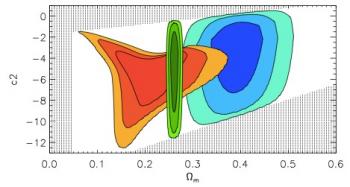Publications majeures de SNLS :
- Astier P. et al, ‘The Supernova Legacy Survey: Measurement of Omega_M, Omega_Lambda and w from the First Year Data Set’, 2006, A&A, 447,31
- Guy J. et al., 2010, ‘The Supernova Legacy Survey 3-year sample: Type Ia Supernovae photometric distances and cosmological constraints’, 2010, A&A, 523, A7
- Conley A. et al, ‘Supernova Constraints and Systematic Uncertainties from the First 3 Years of the Supernova Legacy Survey’, 2011, ApJS, 192,1.
- Betoule M. et al.,’Improved cosmological constraints from a joint analysis of the SDSS-II and SNLS supernova samples’, 2014, A&A, 568, A22
Publications du groupe du DPhP :
- Bazin G. et al, ‘The Core-collapse rate from the Supernova Legacy Survey’, 2009, A&A, 499, 653
- Palanque-Delabrouille N. et al, ‘Photometric redshifts for supernovae Ia in the Supernova Legacy Survey’, 2010, A&A, 514, A63
- Bazin G. et al, ‘Photometric selection of Type Ia supernovae in the Supernova Legacy Survey’, 2011, A&A, 534, A43
- Neveu J. et al, ‘Experimental constraints on the uncoupled Galileon model from SNLS3 data and other cosmological probes’, 2013, A&A, 555, A53
- Neveu J. et al, ‘First experimental constraints on the disformally coupled Galileon model’, 2014, A&A 569, A90
- Möller A. et al, ‘SNIa detection in the SNLS photometric analysis using Morphological Component Analysis’, 2015, JCAP, 04, 041M
- Neveu J. et al, ‘Constraining the ΛCDM and Galileon models with recent cosmological data’, arXiv:1605.02627, accepté pour publication dans A&A
- Möller A. et al., ‘Photometric classification of type Ia supernovae in the SuperNova Legacy Survey with supervised learning’, 2016, JCAP, 12, 008M

Contraintes sur deux des paramètres d’un modèle Galiléon réduit à sa solution dite ‘tracker’. Les contraintes des supernovae Ia (bleu), du rayonnement fossile combiné aux oscillations de baryons (vert) et du taux de croissance des structures (orange) sont en fort désaccord. Cette solution est donc rejetée. Par contre, le modèle du Galiléon général est en aussi bon accord avec ces mêmes données que le modèle de la constante cosmologique. Tiré de Neveu et al., arXiv:1605.02627.
Thèses effectuées dans le groupe du DPhP :
V. Lusset (2003-2006), G. Bazin (2005-2008), J. Neveu (2011-2014), A. Möller (2012-2015).

